Anthurium
regale
Linden
The Regal Anthurium
Originally identified in 1888, a specimen of Anthurium regale
is often difficult to locate and some find it difficult to grow.
An exquisite aroid, A. regale can also be pricey when you are
fortunate enough to locate a specimen. When I first saw a photograph of
the very rare Peruvian beauty in 2005 I immediately began a hunt to
find one. We now have two. Fortunately, some friends in Fort Lauderdale knew exactly
where to look and
some months later the plant was on it's way from South America.
An aroid native of Peru's Rio Huallaga valley
with collections normally made north of Tingo Maria and Juanjui in central
Peru, a large number of botanically collected specimens were found near San Martín.
The aroid is a member of section Cardiolonchium,
a section characterized by plants with leaf blades that
are velutinous and appear velvety on the
upper surface. Other well known members of this
Anthurium section include
Anthurium
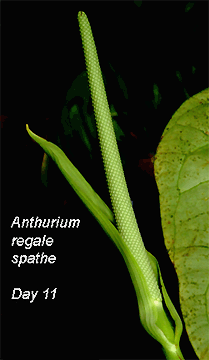 crystallinum, A. magnificum
and A. warocqueanum.
Despite the common misconception Anthurium regale is common to Ecuador
and Colombia, it is
not. The Missouri Botanical Garden's TROPICOS shows absolutely no collection records for Ecuador and
only one specimen record can
be found for Colombia. After some research and consultation with the
experts at MOBOT, the specimen in Colombia was determined to likely have actually been
Anthurium magnificum. A. magnificum
is a similar yet not as stunning Colombian species sometimes confused with
A. regale. It is commonly
accepted the species is from Ecuador since the Anthurium is often exported by an Ecuadorian grower to
collectors in the United States. According to several experts, their stock apparently comes from
Peru. However, Anthurium species are known to be highly
variable and not every leaf of every specimen will always appear the same.
This link explains in greater detail the scientific principle of natural
variation and morphogenesis.
Click here.
crystallinum, A. magnificum
and A. warocqueanum.
Despite the common misconception Anthurium regale is common to Ecuador
and Colombia, it is
not. The Missouri Botanical Garden's TROPICOS shows absolutely no collection records for Ecuador and
only one specimen record can
be found for Colombia. After some research and consultation with the
experts at MOBOT, the specimen in Colombia was determined to likely have actually been
Anthurium magnificum. A. magnificum
is a similar yet not as stunning Colombian species sometimes confused with
A. regale. It is commonly
accepted the species is from Ecuador since the Anthurium is often exported by an Ecuadorian grower to
collectors in the United States. According to several experts, their stock apparently comes from
Peru. However, Anthurium species are known to be highly
variable and not every leaf of every specimen will always appear the same.
This link explains in greater detail the scientific principle of natural
variation and morphogenesis.
Click here.
 With it's
coriaceous (leathery) leaves,
Anthurium regale can grow stunningly large. If you offer a
specimen the conditions it prefers A. regale will reward you with incredible growth and eventually
attain leaves that may exceed 3 feet (90cm), sometimes larger!
Collectors who have observed the plant in Peru report specimens with leaves
approaching 6 feet (2 meters). One internet discussion group states the
Anthurium is a "slow grower", but
personal experience has shown the plant grows quickly. Both of our
specimens produce a new leaf approximately every three months. The key
appears to be giving the species conditions
it prefers and deserves.
With it's
coriaceous (leathery) leaves,
Anthurium regale can grow stunningly large. If you offer a
specimen the conditions it prefers A. regale will reward you with incredible growth and eventually
attain leaves that may exceed 3 feet (90cm), sometimes larger!
Collectors who have observed the plant in Peru report specimens with leaves
approaching 6 feet (2 meters). One internet discussion group states the
Anthurium is a "slow grower", but
personal experience has shown the plant grows quickly. Both of our
specimens produce a new leaf approximately every three months. The key
appears to be giving the species conditions
it prefers and deserves.
Anthurium reproduce via the
production of an inflorescence which
contains a spathe and a fleshy spadix.
The spathe is not a flower but is instead a
modified leaf.
An aroid,
the inflorescence of any aroid is
composed of a spathe, which many people incorrectly believe is a
"flower", and a spadix which is at the spathe's center. The
spathe is more like a "flower holder"
since it is a modified leaf or bract
. The
flowers of Araceae are very small and grow along the spadix
and can rarely be seen with
the naked eye.
The
spathe
appears in the
shape of a hood while the spadix
that holds the flowers is
a spike on a thickened fleshy axis.
In
botany a bract is a specialized leaf that is
associated with the reproductive structure
of the plant. The spadix can only
produce flowers at sexual anthesis.
True flowers contain
near microscopic sexual parts including
anthers, stamens, and stigmas. Some
aroids have tepals but others do not.
The spathe itself contains no sexual characteristics
but all can be observed with a good magnifying glass on the spadix.
If these tiny flowers are pollinated then
fruit in the form of berries containing
seeds will eventually be produced.
Anthurium differ from Philodendron
species since all Anthurium produce
perfect flowers containing both male and
female organs while Philodendron
produce imperfect flowers containing only a
single sex. When an
Anthurium is "in flower" the reference is to the tiny flowers
containing both male and female sexual parts
that grow on the spadix at the center of the
inflorescence. To help prevent self pollination nature has
designed the female flowers to be receptive before the male portion of
the flower
produce their pollen so in most cases an insect must bring pollen from
another plant.
The inflorescence of any aroid species is unique and is a primary
method used by botanists to determine the species of the aroid.
Regardless of the aroid's structure the basic
reproduction and pollination techniques are similar but the
pollination of an aroids is dependent on which of two basic flower
configurations may
be involved and all Anthurium species are unisexual since
their flowers are "perfect".
Anthurium reproduce via the
production of an inflorescence which
contains a spathe and a fleshy spadix.
The spathe is not a flower but is instead a
modified leaf. Anthurium differ
from Philodendron species since all
Anthurium produce perfect flowers
containing both male and female organs while
Philodendron produce imperfect
flowers containing only a single sex. When an
Anthurium is "in flower" the reference is to the tiny flowers
containing both male and female sexual parts
that grow on the spadix at the center of the
inflorescence. To help prevent self pollination nature has
designed the female flowers to be receptive before the male portion of
the flower
produce their pollen so in most cases an insect must bring pollen from
another plant.
In late 2006 I received a personal phone call from Dr. Mardy Darian, an
Anthurium sp. grower from Vista, California. Dr. Darian has
one of the finest Anthurium collections in North America but lives in an extremely dry climate. During
the call, and several subsequent calls I made to him, Dr. Darian told me
about his
specimens, one of which now has leaves close to 4 feet (120cm)! Many of Dr. Darian's stunning
Anthurium specimens were recently seen on the internet
discussion group Aroid l and the photo seen here of his large Anthurium regale can
often be found on the internet. His A. regale is one of few
in cultivation that has set
seeds, a rare event for collectors.
I asked botanist Dr.
Tom Croat of the Missouri Botanical Garden during a personal visit in 2006 how some growers,
such as Dr. Darian, are able to have
their plants constantly exceed the expected blade size. Dr. Croat responded
the size of many aroids is limited only by the quality of their growing
conditions. Ideal conditions along with fertilizer and the lack of
predation allow the plants to simply keep growing larger. Dr. Darian
recently explained in another conversation, he at times would prevent his
specimen from producing a spathe and spadix in to induce additional
leaf growth. Once a specimen begins to reproduce it apparently puts
more energy into seed production and less into producing larger leaves.
In early 2007 our specimen produced a spathe and spadix and the subsequent
leaf was substantially smaller than many previously seen on the same plant. Dr. Darian explained that once he began to allow the plant to produce viable
seeds the plant also produced substantially smaller leaf blades.
Due to his very dry climate
Dr. Darian has an unusual
method of perpetually watering as well as maintaining high humidity around his plants. Although
Anthurium regale is not known scientifically as an "aquatic" plant, Dr.
Darian grows his small plant (often in sphagnum moss) in pans of shallow
water approximately 1/2 inch (1.25cm) deep. He does
this in to keep humidity around the leaves while constantly providing water to the roots.
An experienced Anthurium grower who has visited with Dr. Darian explained in
a recent email that all of Dr. Darian's mature plants were acquired as adult
or near adult stock and are grown potted in a fast draining soil mixture in
large trash containers. I
believe from my conversations with Dr. Darian his method is not actually
attempting to grow the plant "in water" as some on the internet
including one seller have implied. Instead, since he often uses
sphagnum moss to wrap the root system, he simply allows the pot filled with
moss to sit in a shallow water bath. The plant is not growing in
water! He is simply using the moss as a "wick". The moss
appears to soak up the water making it
constantly available to the plant's roots. Many Anthurium growers are now
using this method to start seeds and allow them to reach a juvenile size
before repotting. However, every succesful grower I have spoken with
soon transfers the plants to a porous soil mix.
As a result of Dr. Darian's method,
some
growers and sellers have appeared to suggest Anthurium regale can be grown as an aquatic
plant. No scientific evidence to support that suggestion can be found. But since Dr. Darian
reports he has over 1,000 of these plants growing from seed his method apparently works
well as a means of germinating seed. I have received several emails from growers who have d
small A. regale specimens still wrapped in moss from a large plant
retailer. Some are afraid to remove the moss saying they were advised
to continue to grow the plant "in water". Each grower will have to
make his/her own decision on this matter but it would appear wise to
transfer the plant to a very loose soil mixture and keep it both humid and
damp while it begins to develop a good root system and grows into the large
and beautiful plant it is intended to become.
The species is
found along the edge of the cool (not cold) Andes Mountains at relatively low elevations.
It is not epiphytic, but instead is a terrestrial Anthurium growing in the
ground. Epiphytic species are those that grow attached to another
plant such as a tree which is not the case with Anthurium regale. The average temperature of the region in Peru where
Anthurium regale is
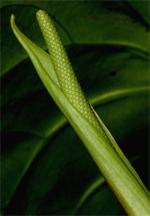 endemic is 20 to 28 degrees Celsius (C).
Converted to Fahrenheit (F), that is in the high 60 degree to low 80 degree
range, or roughly room temperature to warm. A few growers are now
saying on internet discussion groups Anthurium regale does not care if it is grown in hot
conditions. Although it is somewhat adaptable, that does not appear to be supported in nature. It is
also not supported by growers who have reported loss of the plant
attempting to grow it in very hot conditions. The
Anthurium is found in a very narrow climatic range in one particular major valley exclusively in Peru.
More than one grower has lost a specimen. The rapid growth and size of Dr. Darian's
plants, as well as our fast growing specimen, appears to indicate A. regale is
pleased with the higher humidity and cooler conditions we offer. The
natural humidity level of the rain forest is near 100% at all times. As a result
of not being able to provide similar conditions,
some experience difficulty having the plant prosper.
endemic is 20 to 28 degrees Celsius (C).
Converted to Fahrenheit (F), that is in the high 60 degree to low 80 degree
range, or roughly room temperature to warm. A few growers are now
saying on internet discussion groups Anthurium regale does not care if it is grown in hot
conditions. Although it is somewhat adaptable, that does not appear to be supported in nature. It is
also not supported by growers who have reported loss of the plant
attempting to grow it in very hot conditions. The
Anthurium is found in a very narrow climatic range in one particular major valley exclusively in Peru.
More than one grower has lost a specimen. The rapid growth and size of Dr. Darian's
plants, as well as our fast growing specimen, appears to indicate A. regale is
pleased with the higher humidity and cooler conditions we offer. The
natural humidity level of the rain forest is near 100% at all times. As a result
of not being able to provide similar conditions,
some experience difficulty having the plant prosper.
Two growers have sent email challenging my explanation
as to how I
believe this plant should be grown. That is fine. One stated he
grew his plant on a window sill and watered it infrequently. That may
work. But when I asked about the size of the plant I did not receive a
response. Another was pleased the leaves of their plant had
reached approximately 8 inches (20cm) in size in one year. If you are pleased
with a plant that remains small in size and consider it is growing
adequately in low humidity and with infrequent water, I cannot argue with
your achievement. But our plant has grown a leaf almost 2 1/2 feet
(75cm) wide in
the first year of growth, is now producing an even larger leaf, and has recently produced a spathe and spadix.
The production of a spathe is an indication the plant is trying to reproduce
itself. The rapid growth and attempt to reproduce itself would indicate it is
apparently happier with frequent water, cool temperatures and a high humidity.
Another indication my observations are accurate is the amount of mail I
receive from knowledgeable growers, and a few researchers, who have
increased the amount and humidity with moderate light surrounding their specimens
with discernable results in increased growth. However, some
experienced growers have reported success growing Anthurium regale is
low light.
In first year
since it arrived our A. regale produced
five new leaves. One was accidentally destroyed and I thought a 6th was just beginning to develop (December, 2006).
It has turned out not to be a new leaf...... It was a spathe! This
 is
the first time I've personally seen an Anthurium regale spathe and began photographing it in to document the development.
(To see photos of the spathe and spadix as they develop click on the
photo to the right.)
The fragile new leaf
I destroyed was hit with a
stream of water which caused the leaf to shred. The largest leaf is now just a "teenager"
at 29 inches (73cm). The longest petiole is currently over 90cm (3
feet) long. A fully grown plant is both enormous and
exotically beautiful. We grow our A. regale in a very large pot
in indirect light plus we allow for ample air circulation. The plant is
situated near the pond with constantly high humidity. Water drips from the ceiling
almost all the time. Dr. Darian grows his
Anthurium regale
specimens in high humidity but prefers low light. I
cannot argue with his outstanding success. But the real key to success appears to
be the high level of humidity.
is
the first time I've personally seen an Anthurium regale spathe and began photographing it in to document the development.
(To see photos of the spathe and spadix as they develop click on the
photo to the right.)
The fragile new leaf
I destroyed was hit with a
stream of water which caused the leaf to shred. The largest leaf is now just a "teenager"
at 29 inches (73cm). The longest petiole is currently over 90cm (3
feet) long. A fully grown plant is both enormous and
exotically beautiful. We grow our A. regale in a very large pot
in indirect light plus we allow for ample air circulation. The plant is
situated near the pond with constantly high humidity. Water drips from the ceiling
almost all the time. Dr. Darian grows his
Anthurium regale
specimens in high humidity but prefers low light. I
cannot argue with his outstanding success. But the real key to success appears to
be the high level of humidity.
Click the photo to follow the progress of the spathe.
We maintain high humidity around the plant with the aid
of several thousand gallons of pond water just feet from most of our
Anthurium species. A waterfall constantly creates spray, thus
moisture in the air, thus humidity.
You can accomplish a high humidity zone around your specimen by simply
placing a pan of water beneath the pot so the humidity evaporates around the
leaves. A simple aquarium air pump and air stone will help to increase
the evaporation. I do not recommend sitting the pot in the water!
To keep it cool, some growers actually give
Anthurium regale an air-conditioned corner of the
greenhouse often called a "cool wall". In our atrium the
Anthurium
benefits from temperatures similar to the plant's natural condition in Peru.
The temperatures average in the 60's to low 80's F (15.5 to 21 C) during fall, winter, and spring along with a perpetually high humidity level of 85%,
often much higher. We do experience hot temperatures in late summer
but only for a few weeks. Our specimen is watered almost daily in the
summer, 3 to 4 days a week in winter. Dr. Darian
sometimes cautions Anthurium regale is "dead if you let it dry out". One noted collector/researcher
advised she has had good success with the plant in the heat of the year
without damage to her multiple specimens which were wild collected.
She has even allowed the plants to dry, just not to any extreme.
During the winter I allowed the plant to go un-watered for 4 days and the
edges of the largest leaf all began to brown. Made a believer out of
me! This plant does not appear to like having the roots dry out.
As is illustrated by one of Dr. Croat's photos and a description on TROPICOS
(Missouri Botanical Garden) it is sometimes found growing alongside old
roads in relatively bright light. Information received from
field collectors who have observed the plant in Peru
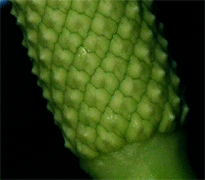 indicates the
Anthurium grows in a variety of lighting conditions. One field researcher told me in a
personal email the aroid "definitely grows in well drained soil sometimes on
the alluviums near streams and sometimes on roadside banks, never at the
water's edge or in mucky soil." (An alluvium is soil deposited by
a river or other running water.) Records appear to
indicate in nature the plant
receives primarily moderate light. Our plant receives filtered
light (approximately 40 to 50%) and,
as is demonstrated by the relatively fast growth of large leaves and a
spathe, is prospering. One website seems to suggest extremely low light (near
dark) based on information purportedly from Dr. Darian. The good doctor grows
younger plants beneath his greenhouse benches. Moderately low to moderately bright light
appears to satisfy the
plant.
indicates the
Anthurium grows in a variety of lighting conditions. One field researcher told me in a
personal email the aroid "definitely grows in well drained soil sometimes on
the alluviums near streams and sometimes on roadside banks, never at the
water's edge or in mucky soil." (An alluvium is soil deposited by
a river or other running water.) Records appear to
indicate in nature the plant
receives primarily moderate light. Our plant receives filtered
light (approximately 40 to 50%) and,
as is demonstrated by the relatively fast growth of large leaves and a
spathe, is prospering. One website seems to suggest extremely low light (near
dark) based on information purportedly from Dr. Darian. The good doctor grows
younger plants beneath his greenhouse benches. Moderately low to moderately bright light
appears to satisfy the
plant.
One website, as
well as a discussion group, suggest growing the Anthurium in water.
As explained above, that may not be wise for the average grower but appears to be possible if you live in a very dry climate and have the roots
devoid of soil and wrapped in sphagnum
potted in
very shallow water similar to Dr. Darian's method. But it also appears the real goal
in Dr. Darian's case is to have
both water and humidity available to the aroid at all times.
Since the plant is expensive, I recommend caution if you plan to attempt growing it in
water. If you are as experienced as Dr. Darian,
and have over 1000 plants to experiment with, perhaps.
I posed the
question of why Dr. Darian's technique appears to work to Dr. Croat,
America's top aroid botanist. He responded, "Few aroids grow in
standing water but I think what happens is the plants adapt to having their
roots skim the water to collect both water and still get air. They
seem to be able to stand water better if there is no soil. For
example, you can put Dieffenbachia directly into a pail of water and it
seems to thrive." However, as one researcher
stated above, in Peru the Anthurium is "never at the water's edge or in mucky
soil".
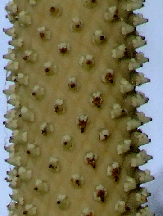 High humidity and damp well drained potting media appear crucial. Our potting mixture
holds moisture well, is
very loose, fast draining, and very porous. It is composed of roughly
30% good potting soil, 20% peat, 10% Perlite™,
and the balance orchid potting
media with lots of wood chips and charcoal. We keep the potting media damp at all times. After seeing the
photo of our specimen, I have received several requests from growers in Florida asking how to save their beloved
plant. All I can offer is to avoid excessive heat, increase
the humidity, and keep the
potting media damp and well drained. Never dry! Other successful
growers in Florida have recently told me they are changing to just such a
soil mixture. One is using 50% fast draining porous soil and 50%
chucks of Perlite™.
High humidity and damp well drained potting media appear crucial. Our potting mixture
holds moisture well, is
very loose, fast draining, and very porous. It is composed of roughly
30% good potting soil, 20% peat, 10% Perlite™,
and the balance orchid potting
media with lots of wood chips and charcoal. We keep the potting media damp at all times. After seeing the
photo of our specimen, I have received several requests from growers in Florida asking how to save their beloved
plant. All I can offer is to avoid excessive heat, increase
the humidity, and keep the
potting media damp and well drained. Never dry! Other successful
growers in Florida have recently told me they are changing to just such a
soil mixture. One is using 50% fast draining porous soil and 50%
chucks of Perlite™.
My suggestions as to our observations and the methods
we use
to grow this plant
have been debated by a few growers on the internet.
That's fine. Successful growers often disagree on growing methods. If you are able to grow the
Anthurium successfully, other
methods may work well. Some growers can and do make this plant grow on a
windowsill and are happy with their results. My goal is to not simply keep it alive but to make
Anthurium regale produce large leaves, as it does in the wild, as well
as prosper
with the ultimate goal being to learn how to produce seeds as well as reproduce the plant.
(Read the discussion on the attached page regarding reproduction). I base the suggestion of cool temperatures and high
humidity along with damp well drained potting media on scientific information and email exchanges with
growers and researchers who
have seen and studied the plant in Peru. We also now have Anthurium
regale pollen in the freezer! I would consider that an indication
the plant likes the conditions we offer.
This plant can easily cost upwards of
$100 and it would appear prudent to offer the species the conditions it
receives in nature in to have it flourish. Since Anthurium
regale appears to prefer cooler temperatures and very high humidity in
nature,
something
many growers cannot easily offer, the species may not be suitable
for some growers. That does not mean you cannot grow the plant if you
don't provide the same conditions we offer. I offer information to
those who wish to grow it well. Recently available information on supplies from
South America indicates the price
may soon climb even higher on an individual specimen due to export
restrictions from Peru.
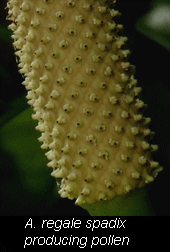 Two interesting observations have been noted during
the growth of the spathe and spadix. The majority of Anthurium species
produce pollen from the bottom of the spadix upwards. Anthurium
regale does it in reverse! Dr. Croat commented
regarding the unusual nature of what we had observed. Should you choose
to read the following pages of notes on the flowering of the species you'll
learn the plant takes almost 2 months before the spadix begins to produce
pollen. We were fortunate enough to have been able to photograph the
pollen developing. And you'll learn more about the nature of the pattern
of the stamens as they extend. Despite the stamen production from top
down the pattern as the stamens extend is normal from each tiny flower.
And to our surprise, once the spadix had completed pollen production in
suddenly turned purple over night! All of that progression is
documented on the spathe and spadix pages which follow. We were also
successful in collecting pollen which is now frozen and awaiting the
production of another spathe.
Two interesting observations have been noted during
the growth of the spathe and spadix. The majority of Anthurium species
produce pollen from the bottom of the spadix upwards. Anthurium
regale does it in reverse! Dr. Croat commented
regarding the unusual nature of what we had observed. Should you choose
to read the following pages of notes on the flowering of the species you'll
learn the plant takes almost 2 months before the spadix begins to produce
pollen. We were fortunate enough to have been able to photograph the
pollen developing. And you'll learn more about the nature of the pattern
of the stamens as they extend. Despite the stamen production from top
down the pattern as the stamens extend is normal from each tiny flower.
And to our surprise, once the spadix had completed pollen production in
suddenly turned purple over night! All of that progression is
documented on the spathe and spadix pages which follow. We were also
successful in collecting pollen which is now frozen and awaiting the
production of another spathe.
Our original Anthurium regale specimen was located
by Natural Selections Exotics in Fort Lauderdale, FL.
In an attempt to have pollen available once a new spathe appears we have
added a second plant. The new plant has leaves of approximately 30cm
(12 inches) and came from Dr. Ron Kaufmann in San Diego. We suspect it
will take
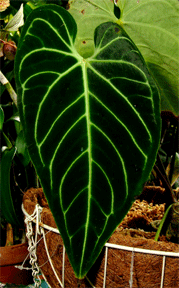 approximately one year for the second plant to grow large enough
to produce a spathe. The new specimen has intensely velvet leaves,
much more so than our large specimen. In just the first two months
since it arrived the specimen had already developed a new leaf. By
five months it had developed two!
approximately one year for the second plant to grow large enough
to produce a spathe. The new specimen has intensely velvet leaves,
much more so than our large specimen. In just the first two months
since it arrived the specimen had already developed a new leaf. By
five months it had developed two!
A truly rare Anthurium,
Anthurium regale is one almost any collector would love to add to a
collection! But if you wish to grow it well be sure and give the plant
what it expects and deserves: cool, very humid, damp and well drained growing conditions!
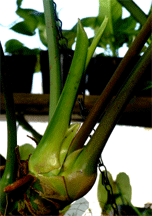 Interestingly,
the older plant began to develop a new leaf approximately 40 days after
the spathe began to open. The development of that new leaf was tracked on the spathe and spadix pages as well.
As noted earlier, it did not reach the size of the previous large leaf but that leaf was
almost immediately followed by another new leaf. That leaf appears
it may be the largest yet!
Interestingly,
the older plant began to develop a new leaf approximately 40 days after
the spathe began to open. The development of that new leaf was tracked on the spathe and spadix pages as well.
As noted earlier, it did not reach the size of the previous large leaf but that leaf was
almost immediately followed by another new leaf. That leaf appears
it may be the largest yet!
If you are seeking
information on other rare species, click on "Aroids and other genera in the Collection"
at the top and look for the

![]()
![]()
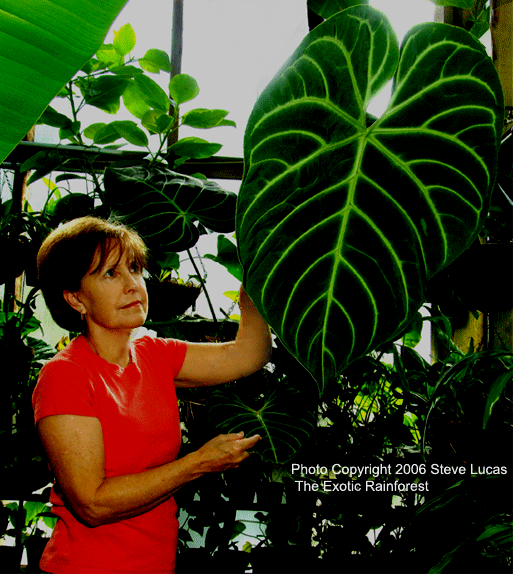
 crystallinum, A. magnificum
and A. warocqueanum.
Despite the common misconception Anthurium regale is common to Ecuador
and Colombia, it is
not. The Missouri Botanical Garden's TROPICOS shows absolutely no collection records for Ecuador and
only one specimen record can
be found for Colombia. After some research and consultation with the
experts at MOBOT, the specimen in Colombia was determined to likely have actually been
Anthurium magnificum. A. magnificum
is a similar yet not as stunning Colombian species sometimes confused with
A. regale. It is commonly
accepted the species is from Ecuador since the Anthurium is often exported by an Ecuadorian grower to
collectors in the United States. According to several experts, their stock apparently comes from
Peru. However, Anthurium species are known to be highly
variable and not every leaf of every specimen will always appear the same.
This link explains in greater detail the scientific principle of natural
variation and morphogenesis.
Click here.
crystallinum, A. magnificum
and A. warocqueanum.
Despite the common misconception Anthurium regale is common to Ecuador
and Colombia, it is
not. The Missouri Botanical Garden's TROPICOS shows absolutely no collection records for Ecuador and
only one specimen record can
be found for Colombia. After some research and consultation with the
experts at MOBOT, the specimen in Colombia was determined to likely have actually been
Anthurium magnificum. A. magnificum
is a similar yet not as stunning Colombian species sometimes confused with
A. regale. It is commonly
accepted the species is from Ecuador since the Anthurium is often exported by an Ecuadorian grower to
collectors in the United States. According to several experts, their stock apparently comes from
Peru. However, Anthurium species are known to be highly
variable and not every leaf of every specimen will always appear the same.
This link explains in greater detail the scientific principle of natural
variation and morphogenesis.
Click here. With it's
coriaceous (leathery) leaves,
Anthurium regale can grow stunningly large. If you offer a
specimen the conditions it prefers A. regale will reward you with incredible growth and eventually
attain leaves that may exceed 3 feet (90cm), sometimes larger!
Collectors who have observed the plant in Peru report specimens with leaves
approaching 6 feet (2 meters). One internet discussion group states the
Anthurium is a "slow grower", but
personal experience has shown the plant grows quickly. Both of our
specimens produce a new leaf approximately every three months. The key
appears to be giving the species conditions
it prefers and deserves.
With it's
coriaceous (leathery) leaves,
Anthurium regale can grow stunningly large. If you offer a
specimen the conditions it prefers A. regale will reward you with incredible growth and eventually
attain leaves that may exceed 3 feet (90cm), sometimes larger!
Collectors who have observed the plant in Peru report specimens with leaves
approaching 6 feet (2 meters). One internet discussion group states the
Anthurium is a "slow grower", but
personal experience has shown the plant grows quickly. Both of our
specimens produce a new leaf approximately every three months. The key
appears to be giving the species conditions
it prefers and deserves.  endemic is 20 to 28 degrees Celsius (C).
Converted to Fahrenheit (F), that is in the high 60 degree to low 80 degree
range, or roughly room temperature to warm. A few growers are now
saying on internet discussion groups Anthurium regale does not care if it is grown in hot
conditions. Although it is somewhat adaptable, that does not appear to be supported in nature. It is
also not supported by growers who have reported loss of the plant
attempting to grow it in very hot conditions. The
Anthurium is found in a very narrow climatic range in one particular major valley exclusively in Peru.
More than one grower has lost a specimen. The rapid growth and size of Dr. Darian's
plants, as well as our fast growing specimen, appears to indicate A. regale is
pleased with the higher humidity and cooler conditions we offer. The
natural humidity level of the rain forest is near 100% at all times. As a result
of not being able to provide similar conditions,
some experience difficulty having the plant prosper.
endemic is 20 to 28 degrees Celsius (C).
Converted to Fahrenheit (F), that is in the high 60 degree to low 80 degree
range, or roughly room temperature to warm. A few growers are now
saying on internet discussion groups Anthurium regale does not care if it is grown in hot
conditions. Although it is somewhat adaptable, that does not appear to be supported in nature. It is
also not supported by growers who have reported loss of the plant
attempting to grow it in very hot conditions. The
Anthurium is found in a very narrow climatic range in one particular major valley exclusively in Peru.
More than one grower has lost a specimen. The rapid growth and size of Dr. Darian's
plants, as well as our fast growing specimen, appears to indicate A. regale is
pleased with the higher humidity and cooler conditions we offer. The
natural humidity level of the rain forest is near 100% at all times. As a result
of not being able to provide similar conditions,
some experience difficulty having the plant prosper.  is
the first time I've personally seen an Anthurium regale spathe and began photographing it in to document the development.
(To see photos of the spathe and spadix as they develop click on the
photo to the right.)
The fragile new leaf
I destroyed was hit with a
stream of water which caused the leaf to shred. The largest leaf is now just a "teenager"
at 29 inches (73cm). The longest petiole is currently over 90cm (3
feet) long. A fully grown plant is both enormous and
exotically beautiful. We grow our A. regale in a very large pot
in indirect light plus we allow for ample air circulation. The plant is
situated near the pond with constantly high humidity. Water drips from the ceiling
almost all the time. Dr. Darian grows his
Anthurium regale
specimens in high humidity but prefers low light. I
cannot argue with his outstanding success. But the real key to success appears to
be the high level of humidity.
is
the first time I've personally seen an Anthurium regale spathe and began photographing it in to document the development.
(To see photos of the spathe and spadix as they develop click on the
photo to the right.)
The fragile new leaf
I destroyed was hit with a
stream of water which caused the leaf to shred. The largest leaf is now just a "teenager"
at 29 inches (73cm). The longest petiole is currently over 90cm (3
feet) long. A fully grown plant is both enormous and
exotically beautiful. We grow our A. regale in a very large pot
in indirect light plus we allow for ample air circulation. The plant is
situated near the pond with constantly high humidity. Water drips from the ceiling
almost all the time. Dr. Darian grows his
Anthurium regale
specimens in high humidity but prefers low light. I
cannot argue with his outstanding success. But the real key to success appears to
be the high level of humidity.
 indicates the
Anthurium grows in a variety of lighting conditions. One field researcher told me in a
personal email the aroid "definitely grows in well drained soil sometimes on
the alluviums near streams and sometimes on roadside banks, never at the
water's edge or in mucky soil." (An alluvium is soil deposited by
a river or other running water.) Records appear to
indicate in nature the plant
receives primarily moderate light. Our plant receives filtered
light (approximately 40 to 50%) and,
as is demonstrated by the relatively fast growth of large leaves and a
spathe, is prospering. One website seems to suggest extremely low light (near
dark) based on information purportedly from Dr. Darian. The good doctor grows
younger plants beneath his greenhouse benches. Moderately low to moderately bright light
appears to satisfy the
plant.
indicates the
Anthurium grows in a variety of lighting conditions. One field researcher told me in a
personal email the aroid "definitely grows in well drained soil sometimes on
the alluviums near streams and sometimes on roadside banks, never at the
water's edge or in mucky soil." (An alluvium is soil deposited by
a river or other running water.) Records appear to
indicate in nature the plant
receives primarily moderate light. Our plant receives filtered
light (approximately 40 to 50%) and,
as is demonstrated by the relatively fast growth of large leaves and a
spathe, is prospering. One website seems to suggest extremely low light (near
dark) based on information purportedly from Dr. Darian. The good doctor grows
younger plants beneath his greenhouse benches. Moderately low to moderately bright light
appears to satisfy the
plant.  High humidity and damp well drained potting media appear crucial. Our potting mixture
holds moisture well, is
very loose, fast draining, and very porous. It is composed of roughly
30% good potting soil, 20% peat, 10% Perlite™,
and the balance orchid potting
media with lots of wood chips and charcoal. We keep the potting media damp at all times. After seeing the
photo of our specimen, I have received several requests from growers in Florida asking how to save their beloved
plant. All I can offer is to avoid excessive heat, increase
the humidity, and keep the
potting media damp and well drained. Never dry! Other successful
growers in Florida have recently told me they are changing to just such a
soil mixture. One is using 50% fast draining porous soil and 50%
chucks of Perlite™.
High humidity and damp well drained potting media appear crucial. Our potting mixture
holds moisture well, is
very loose, fast draining, and very porous. It is composed of roughly
30% good potting soil, 20% peat, 10% Perlite™,
and the balance orchid potting
media with lots of wood chips and charcoal. We keep the potting media damp at all times. After seeing the
photo of our specimen, I have received several requests from growers in Florida asking how to save their beloved
plant. All I can offer is to avoid excessive heat, increase
the humidity, and keep the
potting media damp and well drained. Never dry! Other successful
growers in Florida have recently told me they are changing to just such a
soil mixture. One is using 50% fast draining porous soil and 50%
chucks of Perlite™. Two interesting observations have been noted during
the growth of the spathe and spadix. The majority of Anthurium species
produce pollen from the bottom of the spadix upwards. Anthurium
regale does it in reverse! Dr. Croat commented
regarding the unusual nature of what we had observed. Should you choose
to read the following pages of notes on the flowering of the species you'll
learn the plant takes almost 2 months before the spadix begins to produce
pollen. We were fortunate enough to have been able to photograph the
pollen developing. And you'll learn more about the nature of the pattern
of the stamens as they extend. Despite the stamen production from top
down the pattern as the stamens extend is normal from each tiny flower.
And to our surprise, once the spadix had completed pollen production in
suddenly turned purple over night! All of that progression is
documented on the spathe and spadix pages which follow. We were also
successful in collecting pollen which is now frozen and awaiting the
production of another spathe.
Two interesting observations have been noted during
the growth of the spathe and spadix. The majority of Anthurium species
produce pollen from the bottom of the spadix upwards. Anthurium
regale does it in reverse! Dr. Croat commented
regarding the unusual nature of what we had observed. Should you choose
to read the following pages of notes on the flowering of the species you'll
learn the plant takes almost 2 months before the spadix begins to produce
pollen. We were fortunate enough to have been able to photograph the
pollen developing. And you'll learn more about the nature of the pattern
of the stamens as they extend. Despite the stamen production from top
down the pattern as the stamens extend is normal from each tiny flower.
And to our surprise, once the spadix had completed pollen production in
suddenly turned purple over night! All of that progression is
documented on the spathe and spadix pages which follow. We were also
successful in collecting pollen which is now frozen and awaiting the
production of another spathe. approximately one year for the second plant to grow large enough
to produce a spathe. The new specimen has intensely velvet leaves,
much more so than our large specimen. In just the first two months
since it arrived the specimen had already developed a new leaf. By
five months it had developed two!
approximately one year for the second plant to grow large enough
to produce a spathe. The new specimen has intensely velvet leaves,
much more so than our large specimen. In just the first two months
since it arrived the specimen had already developed a new leaf. By
five months it had developed two!
 Interestingly,
the older plant began to develop a new leaf approximately 40 days after
the spathe began to open. The development of that new leaf was tracked on the spathe and spadix pages as well.
As noted earlier, it did not reach the size of the previous large leaf but that leaf was
almost immediately followed by another new leaf. That leaf appears
it may be the largest yet!
Interestingly,
the older plant began to develop a new leaf approximately 40 days after
the spathe began to open. The development of that new leaf was tracked on the spathe and spadix pages as well.
As noted earlier, it did not reach the size of the previous large leaf but that leaf was
almost immediately followed by another new leaf. That leaf appears
it may be the largest yet!